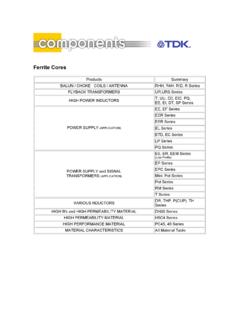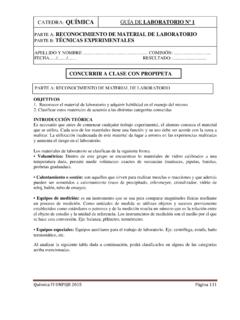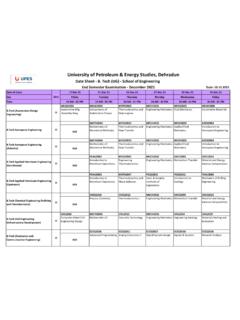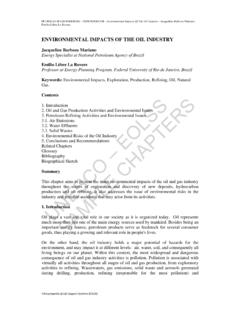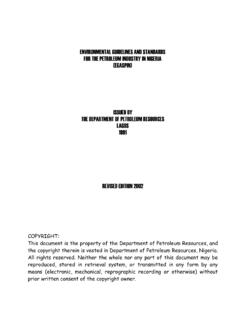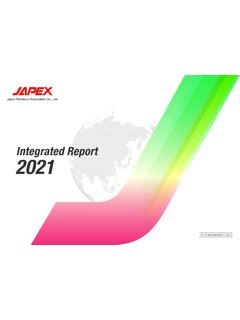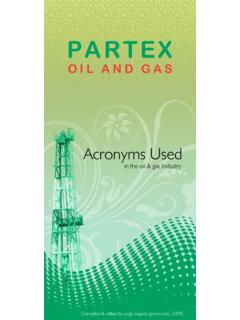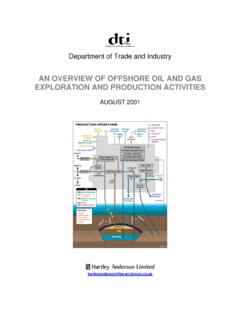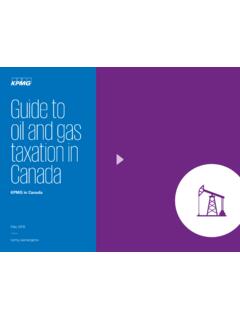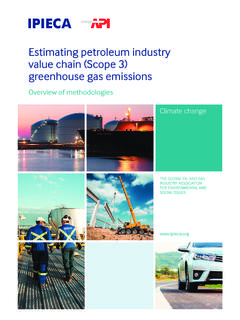Transcription of Developments in Petroleum Science, 8
1 Developments in Petroleum Science, 8fundamentals ofreservoir engineeringFURTHER TITLES IN THIS SERIES1A. GENE COLLINSGEOCHEMISTRY OF OILFIELD FERTLABNORMAL FORMATION SZILASPRODUCTION AND TRANSPORT OF OIL AND CONYBEAREGEOMORPHOLOGY OF OIL AND GAS FIELDSIN SANDSTONE YEN and CHILINGARIAN (Editors)OIL PEACEMANFUNDAMENTALS OF NUMERICAL RESERVOIR CHILINGARIAN and YEN (Editors)BITUMENS, ASPHALTS AND TAR DAKEFUNDAMENTALS OF RESERVOIR ENGINEERING9K. MAGARACOMPACTION AND FLUID SILVIA and ROBINSONDECONVOLUTION OF GEOPHYSICAL TIME SERIES INTHE EXPLORATION FOR OIL AND NATURAL GASD evelopments in Petroleum Science, 8fundamentals ofreservoirengineeringLP. DAKES enior Lecturer in Reservoir Engineering,Shell Internationale Petroleum Maatschappij B. V.,The Hague, The NetherlandsELSEVIER, Amsterdam London New York TokyoELSEVIER SCIENCE Burgerhartstraat Box 211, 1000 AE Amsterdam, The NetherlandsFirst edition 1978 Second impression l979 Third impression 1980 Fourth impression 1981 Fifth impression 1982 Sixth impression 1982 Seventh impression 1983 Eighth impression 1985 Ninth impression 1986 Tenth impression 1988 Eleventh impression 1990 Twelfth impression 1991 Thirteenth impression 1993 Fourteenth impression 1994 Fifteenth impression 1995 Sixteenth impression 1997 Seventeenth impression 1998 ISBN 0-444-41830-X 1978 ELSEVIER SCIENCE All rights part of this publication may be reproduced, stored in a retrieval system ortransmitted in any form or by any means, electronic, mechanical, photocopying,recording or otherwise.
2 Without the prior written permission of the publisher, ElsevierScience , Copyright & Permissions Department, Box 521, 1000 AMAmsterdam, The regulations for readers in the publication has been registered withthe Copyright Clearance Center Inc. (CCC), 222 Rosewood Drive Danvers, MA can be obtained from the CCC about conditions under which photocopiesof parts of this publication may be made in the All other copyright questions,including photocopying outside of the , should be referred to the responsibility is assumed by the publisher for any injury and/or damage to personsor property as a matter of products liability, negligence or otherwise, or from any use oroperation of any methods, products, instructions or ideas contained in the book is printed on acid-free paperPrinted in The NetherlandsTo GracePREFACEThis teaching textbook in Hydrocarbon Reservoir Engineering is based on variouslecture courses given by the author while employed in the Training Division of ShellInternationale Petroleum Maatschappij (SIPM)
3 , in the Hague, between 1974 primary aim of the book is to present the basic physics of reservoir engineering,using the simplest and most straightforward of mathematical techniques. It is onlythrough having a complete understanding of the physics that the engineer can hope toappreciate and solve complex reservoir engineering problems in a practical 1 through 4 serve as an introduction to the subject and contain materialpresented on Shell's basic training courses. They should therefore be of interest toanyone even remotely connected with the business of developing and producinghydrocarbon 5 through 8 are more specialised describing the theory and practice of welltesting and pressure analysis techniques, which are probably the most importantsubjects in the whole of reservoir engineering. The approach is entirely general inrecognising that the superposition of dimensionless pressure, or pseudo pressurefunctions, perm its the analysis of any rate-pressure-time record retrieved from a welltest, for any type of reservoir fluid.
4 To appreciate this generality, the reader is advisedto make a cursory inspection of section (page 295), before embarking on a morethorough reading of these chapters. The author hopes that this will serve as a usefulintroduction to the recently published and, as usual, excellent SPE Monograph(Advances in Well Test Analysis; by Robert C. Earlougher, Jr.), in which a knowledge isassumed of much of the theory presented in these four 9 describes the art of aquifer modelling, while Chapter 10, the final chapter,covers the subject of immiscible, incompressible displacement. The message here is-that there is but one displacement theory, that of Buckley and Leverett. Everything elseis just a matter of "modifying" the relative permeability curves (known in the businessas "scientific adjustment"), to account for the manner in which the fluid saturations aredistributed in the dip-normal direction.
5 These curves can then be used in conjunctionwith the one dimensional Buckley-Leverett equation to calculate the oil recovery. Bystating the physics implicit in the generation of averaged (pseudo) relativepermeabilities and illustrating their role in numerical simulation, it is hoped that thischapter will help to guide the hand of the scientific book also contains numerous fully worked exercises which illustrate the most notable omission, amongst the subjects covered, is the lack of any seriousdiscussion on the complexities of hydrocarbon phase behaviour. This has al readybeen made the subject of several specialist text books, most notably that of Amyx,Bass and Whiting (reference 8, page 42), which is frequently referred to throughout / ACKNOWLEDGEMENTSVIIIA difficult decision to make, at the time of writing, is which set of units to the logical decision has been made that the industry should adopt the SI(Syst me Internationale) units, no agreement has yet been reached concerning theextent to which "allowable" units, expressed in terms of the basic units, will betolerated.
6 To avoid possible error the author has therefore elected to develop theimportant theoretical arguments in Darcy units, while equations required for applicationin the field are stated in Field units. Both these systems are defined in table , inChapter 4, which appropriately is devoted to the description of Darcy's law. Thischapter also contains a section, ( ), which describes how to convert equationsexpressed in one set of units to the equivalent form in any other set of units. Thechoice of Darcy units is based largely on tradition. Equations expressed in these unitshave the same form as in absolute units except in their gravity terms. Field units havebeen used in practical equations to enable the reader to relate to the existing / ACKNOWLEDGEMENTSIXACKNOWLEDGEMENTSThe author wishes to express his thanks to SIPM for so readily granting permission topublish this work and, in particular, to H.
7 L. Douwes Dekker, Kok and C. for their sustained personal interest throughout the writing and publication, whichhas been a source of great those who have offered technical advice, I should like to acknowledge theassistance of Harmsen; Schipper; D. Leijnse; J. van der Burgh; L. Schenk; Engen and H. Brummelkamp, all sometime members of Shell's reservoirengineering staff in the Hague. My thanks for technical assistance are also due to thefollowing members of KSEPL (Koninklijke Shell Exploratie en Productie Laboratorium)in Rijswijk, Holland: J. Offeringa; van Domseiaar; Dumore; J. van Lookerenand Williamson. Further, I am grateful to all former lecturers in reservoirengineering in Shell Training, and also to my successor de la Mar for his manyhelpful suggestions. Sincere thanks also to Christiansen ( Oman) for hisdedicated attitude while correcting the text over a period of several months, andsimilarly to Willetts (Shell Expro, Aberdeen) and Woods (NAM, Assen) fortheir the preparation of the text I am indebted to Fransz for his co-ordinatingwork, and particulariy to Vera A.
8 Kuipers-Betke for her enthusiastic hard work whilecomposing the final copy. For the drafting of the diagrams and the layout I am gratefulto Janse; Slootweg; Bor and , my thanks are due to all those who suffered my lectures between 1974 and1977 for their numerous suggestions which have helped to shape this Dake,Shell Training,The Hague,October OF FIGURESXVIILIST OF TABLESXXVIILIST OF EQUATIONSXXXNOMENCLATURELIXCHAPTER 1 SOME BASIC CONCEPTS IN RESERVOIR OF HYDROCARBON PRESSURE RECOVERY: RECOVERY GAS RESERVOIR OF THE REAL GAS EQUATION OF MATERIAL BALANCE: RECOVERY PHASE BEHAVIOUR37 REFERENCES41 CHAPTER 2 PVT ANALYSIS FOR OF THE BASIC PVT OF FLUID OF THE BASIC PVT PARAMETERS IN THELABORATORY AND CONVERSION FOR FIELD MANNER OF EXPRESSING PVT LABORATORYANALYSIS PVT ANALYSIS69 REFERENCES70 CHAPTER 3 MATERIAL BALANCE APPLIED TO OIL FORM OF THE MATERIAL BALANCE EQUATION FORA HYDROCARBON MATERIAL BALANCE EXPRESSED AS A LINEAR EQUATION DRIVE GAS WATER DRIVE AND RELATED PORE COMPRESSIBILITYPHENOMENA95 REFERENCES98 CHAPTER 4 DARCY'S LAW AND 'S LAW; FLUID : UNITS GAS STEADY STATE FLOW.
9 WELL FLOW: EFFECTIVE AND MECHANICS OF SUPPLEMENTARY RECOVERY121 REFERENCES125 CHAPTER 5 THE BASIC DIFFERENTIAL EQUATION FOR RADIAL FLOW IN APOROUS OF THE BASIC RADIAL DIFFERENTIAL EQUATION OF LINEARIZATION OF EQUATION FOR FLUIDS OF SMALLAND CONSTANT COMPRESSIBILITY133 REFERENCES135 CHAPTER 6 WELL INFLOW EQUATIONS FOR STABILIZED STATE STATE OF THE APPLICATION OF THE STABILIZED FORM OF INFLOW EQUATION UNDER SEMI-STEADY STATE CONDITIONS144 REFERENCES146 CHAPTER 7 THE CONSTANT TERMINAL RATE SOLUTION OF THE RADIALDIFFUSIVITY EQUATION AND ITS APPLICATION TO OILWELL TESTING THE CONSTANT TERMINAL RATE CONSTANT TERMINAL RATE SOLUTION FOR TRANSIENTAND SEMI-STEADY STATE FLOW THEOREM: GENERAL THEORY OF MATTHEWS, BRONS, HAZEBROEK PRESSURE BUILDUP ANALYSIS DRAWDOWN EFFECTS OF PARTIAL WELL PRACTICAL ASPECTS OF WELL ANALYSIS224 REFERENCES236 CONTENTSXIIICHAPTER 8 REAL GAS FLOW: GAS WELL AND SOLUTION OF THE BASIC DIFFERENTIALEQUATION FOR THE RADIAL FLOW OF A REAL RUSSELL, GOODRICH, et.
10 Al. SOLUTION AL-HUSSAINY, RAMEY, CRAWFORD OF THE PRESSURE SQUARED AND PSEUDOPRESSURE SOLUTION OF THE NON-DARCY COEFFICIENT CONSTANT TERMINAL RATE SOLUTION FOR THE FLOWOF A REAL THEORY OF GAS WELL TESTING OF GAS BUILDUP TESTING OF GAS BUILDUP ANALYSIS IN SOLUTION GAS OF PRESSURE ANALYSIS TECHNIQUES291 REFERENCES295 CHAPTER 9 NATURAL WATER UNSTEADY STATE WATER INFLUX THEORY OF HURSTAND VAN OF THE HURST, VAN EVERDINGEN WATERINFLUX THEORY IN HISTORY APPROXIMATE WATER INFLUX THEORY OF FETKOVITCHFOR FINITE THE AMOUNT OF WATER OF INFLUX CALCULATION TECHNIQUES TOSTEAM SOAKING333 REFERENCES335 CONTENTSXIVCHAPTER 10 IMMISCIBLE ASSUMPTIONS AND THEIR FRACTIONAL FLOW ONE DIMENSIONAL RECOVERY UNDER SEGREGATED FLOW FOR THE EFFECT OF A FINITE CAPILLARYTRANSITION ZONE IN DISPLACEMENT IN STRATIFIED WHEN THERE IS A TOTAL LACK OF NUMERICAL SIMULATION OF IMMISCIBLE,INCOMPRESSIBLE DISPLACEMENT405 REFERENCES419 AUTHOR INDEX422 SUBJECT INDEX424 CONTENTSXVEXERCISESEXERCISE GAS PRESSURE GRADIENT IN THE RESERVOIR23 EXERCISE GAS MATERIAL BALANCE33 EXERCISE UNDERGROUND WITHDRAWAL50 EXERCISE CONVERSION OF DIFFERENTIAL LIBERATION DATA TO GIVE THEFIELD PVT PARAMETERS Bo.
